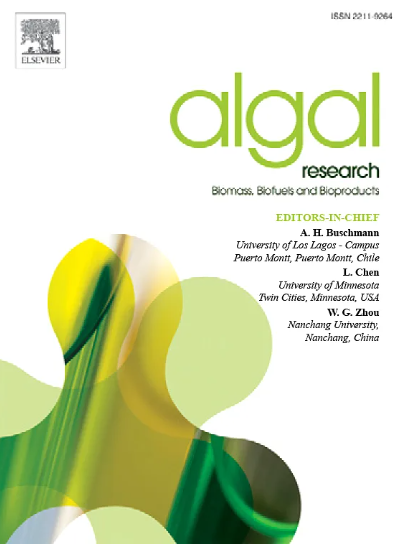Exploring the potential of Baltic macroalgae for food preservation
IF 4.5
2区 生物学
Q1 BIOTECHNOLOGY & APPLIED MICROBIOLOGY
Algal Research-Biomass Biofuels and Bioproducts
Pub Date : 2025-06-15
DOI:10.1016/j.algal.2025.104141
引用次数: 0
Abstract
Despite all technological developments, food spoilage still remains a major economic, environmental and health concern. This study aimed to assess the potential of eight Baltic macroalgae for food preservation, specifically for antimicrobial and antioxidant active food packaging applications. Three brown, three red and two green macroalgae species were extracted automatically by Accelerated Solvent Extraction (ASE) and Supercritical Fluid Extraction (SFE) and evaluated for their antimicrobial effect against nine foodborne pathogens, antioxidant capacity and total phenolic content (TPC). The ASE and SFE extracts of brown algae (Fucus spp.) showed the highest antimicrobial and antioxidative activities and the greatest TPCs. Fucus distichus subsp. evanescens exhibited the highest inhibition against Staphylococcus aureus with IC50 values of 2.1 μg/mL (ASE, H2O:ethanol (50:50) extract) and 4.4 μg/mL (SFE, CO2:Ethanol (50:50). The ethanolic (100 %) ASE and CO2:Ethanol (20:80) SFE extracts of Fucus serratus showed the best antioxidant capacity (IC50s 37.9 μg/mL (ASE) and 24.6 μg/mL (SFE)) and the highest TPCs (158 mg GAE/g (ASE) and 297.41 mg GAE/g (SFE)). Bioactive extracts were further analyzed by UPLC-MS/MS-based untargeted metabolomics. The main components of all extracts were polar lipids (galactolipids and betaine lipids), along with carotenoids, phlorotannins and chlorophylls. These results provide insights into the bioactivity and chemical diversity of Baltic macroalgae, highlighting the potential of Fucus spp. for food preservation.
探索波罗的海巨藻在食品保鲜方面的潜力
尽管有各种技术发展,食品变质仍然是一个主要的经济、环境和健康问题。本研究旨在评估8种波罗的海巨藻在食品保鲜方面的潜力,特别是在抗菌和抗氧化活性食品包装方面的应用。采用加速溶剂萃取法(ASE)和超临界流体萃取法(SFE)自动提取了3种褐藻、3种红藻和2种绿藻,并对其抑菌效果、抗氧化能力和总酚含量(TPC)进行了评价。褐藻(Fucus spp.)的ASE和SFE提取物的抗微生物活性和抗氧化活性最高,TPCs最高。黑角藻亚种。对金黄色葡萄球菌的抑制作用最强,IC50值分别为2.1 μg/mL (ASE, H2O:乙醇(50:50)提取物)和4.4 μg/mL (SFE, CO2:乙醇(50:50)提取物)。结果表明,乙醇(100%)ASE和CO2:乙醇(20:80)SFE提取物的抗氧化能力最佳(ic50为37.9 μg/mL (ASE)和24.6 μg/mL (SFE)), TPCs最高(158 mg GAE/g (ASE)和297.41 mg GAE/g (SFE))。生物活性提取物进一步通过UPLC-MS/MS-based非靶向代谢组学进行分析。所有提取物的主要成分是极性脂质(半乳糖脂质和甜菜碱脂质),以及类胡萝卜素、绿单宁和叶绿素。这些结果为了解波罗的海大型藻类的生物活性和化学多样性提供了新的见解,突出了Fucus spp.在食品保鲜方面的潜力。
本文章由计算机程序翻译,如有差异,请以英文原文为准。
求助全文
约1分钟内获得全文
求助全文
来源期刊

Algal Research-Biomass Biofuels and Bioproducts
BIOTECHNOLOGY & APPLIED MICROBIOLOGY-
CiteScore
9.40
自引率
7.80%
发文量
332
期刊介绍:
Algal Research is an international phycology journal covering all areas of emerging technologies in algae biology, biomass production, cultivation, harvesting, extraction, bioproducts, biorefinery, engineering, and econometrics. Algae is defined to include cyanobacteria, microalgae, and protists and symbionts of interest in biotechnology. The journal publishes original research and reviews for the following scope: algal biology, including but not exclusive to: phylogeny, biodiversity, molecular traits, metabolic regulation, and genetic engineering, algal cultivation, e.g. phototrophic systems, heterotrophic systems, and mixotrophic systems, algal harvesting and extraction systems, biotechnology to convert algal biomass and components into biofuels and bioproducts, e.g., nutraceuticals, pharmaceuticals, animal feed, plastics, etc. algal products and their economic assessment
 求助内容:
求助内容: 应助结果提醒方式:
应助结果提醒方式:


